Charles E W Bean, Diaries, AWM38 3DRL 606/228/1 - Folder - Part 6
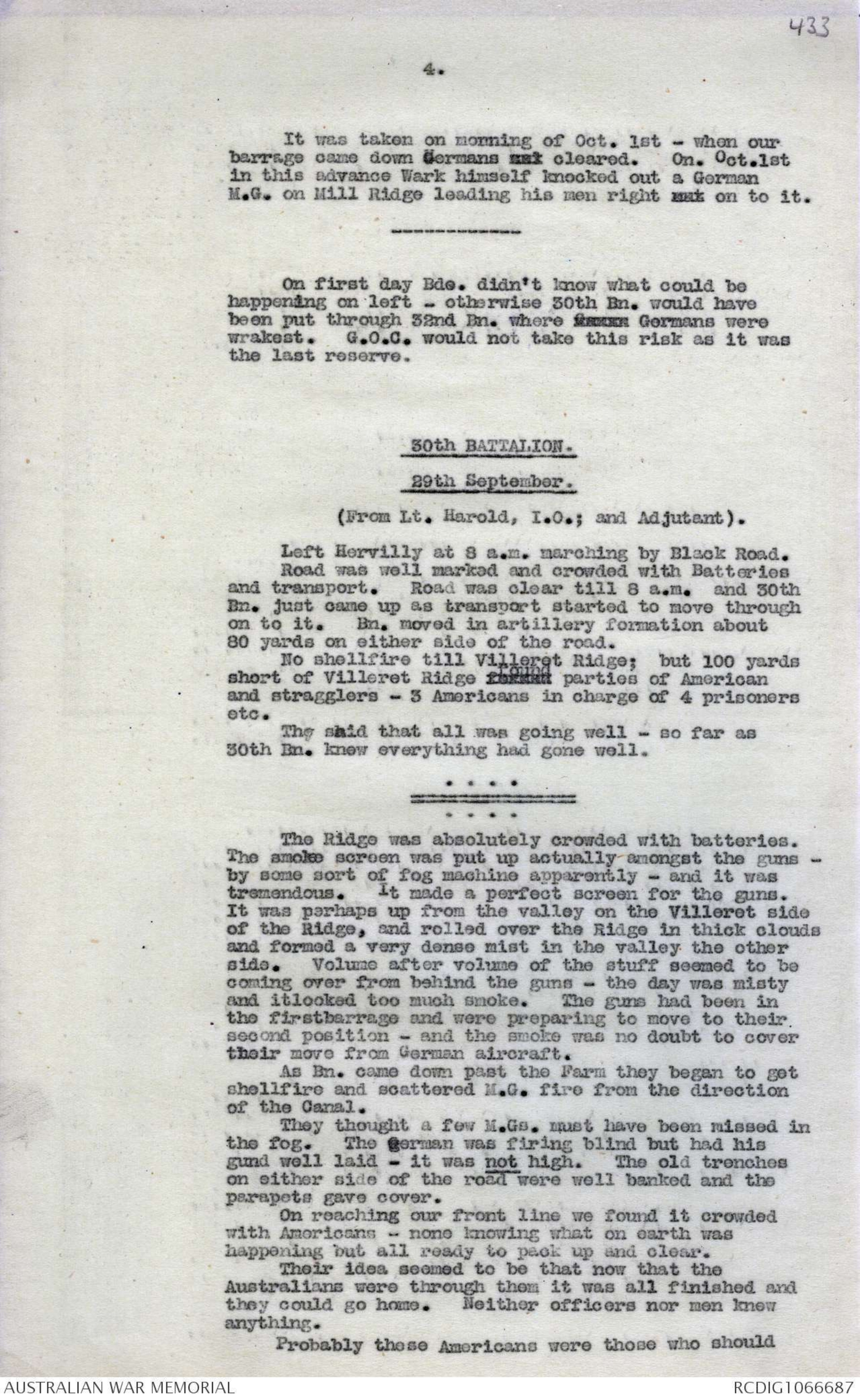
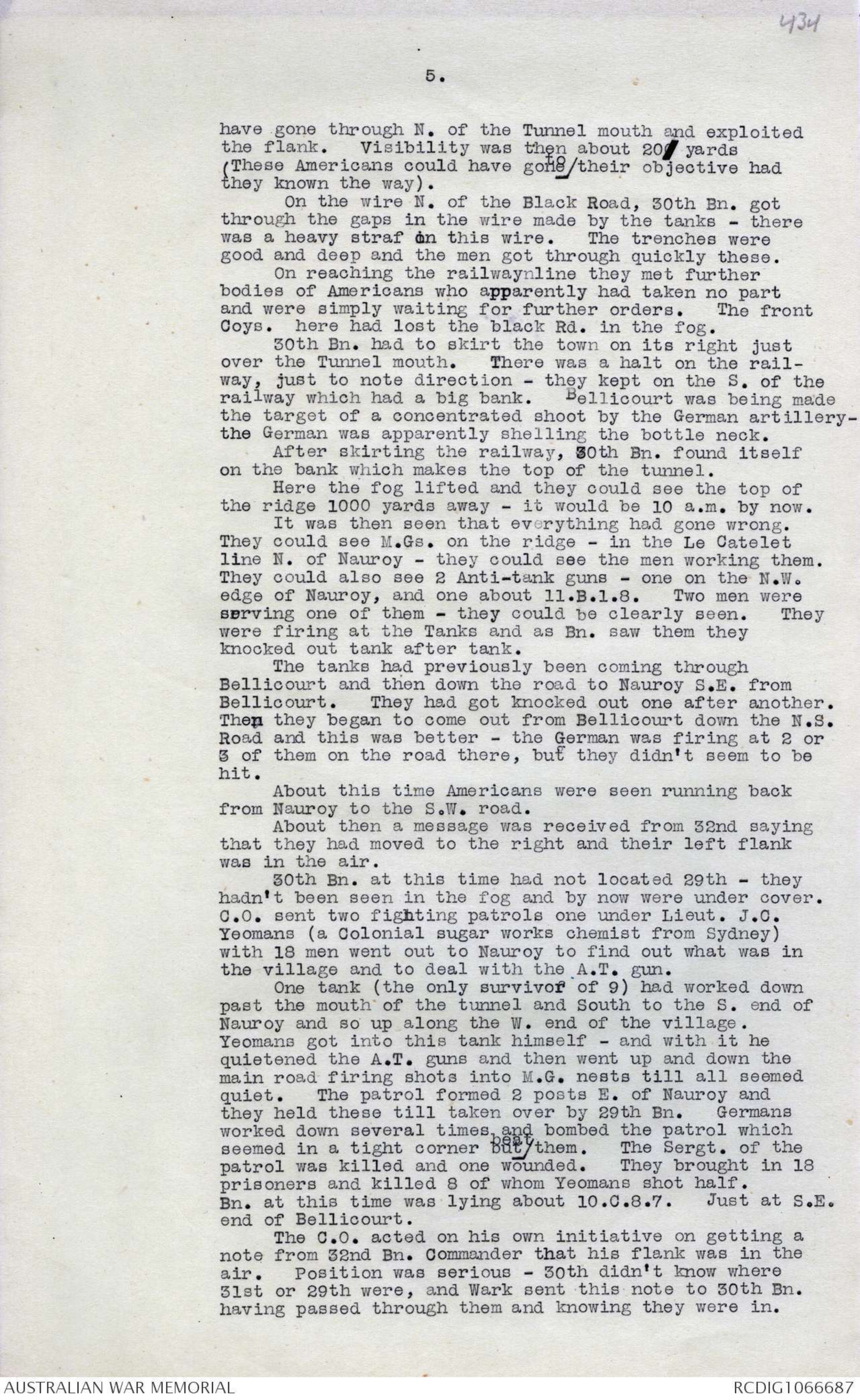
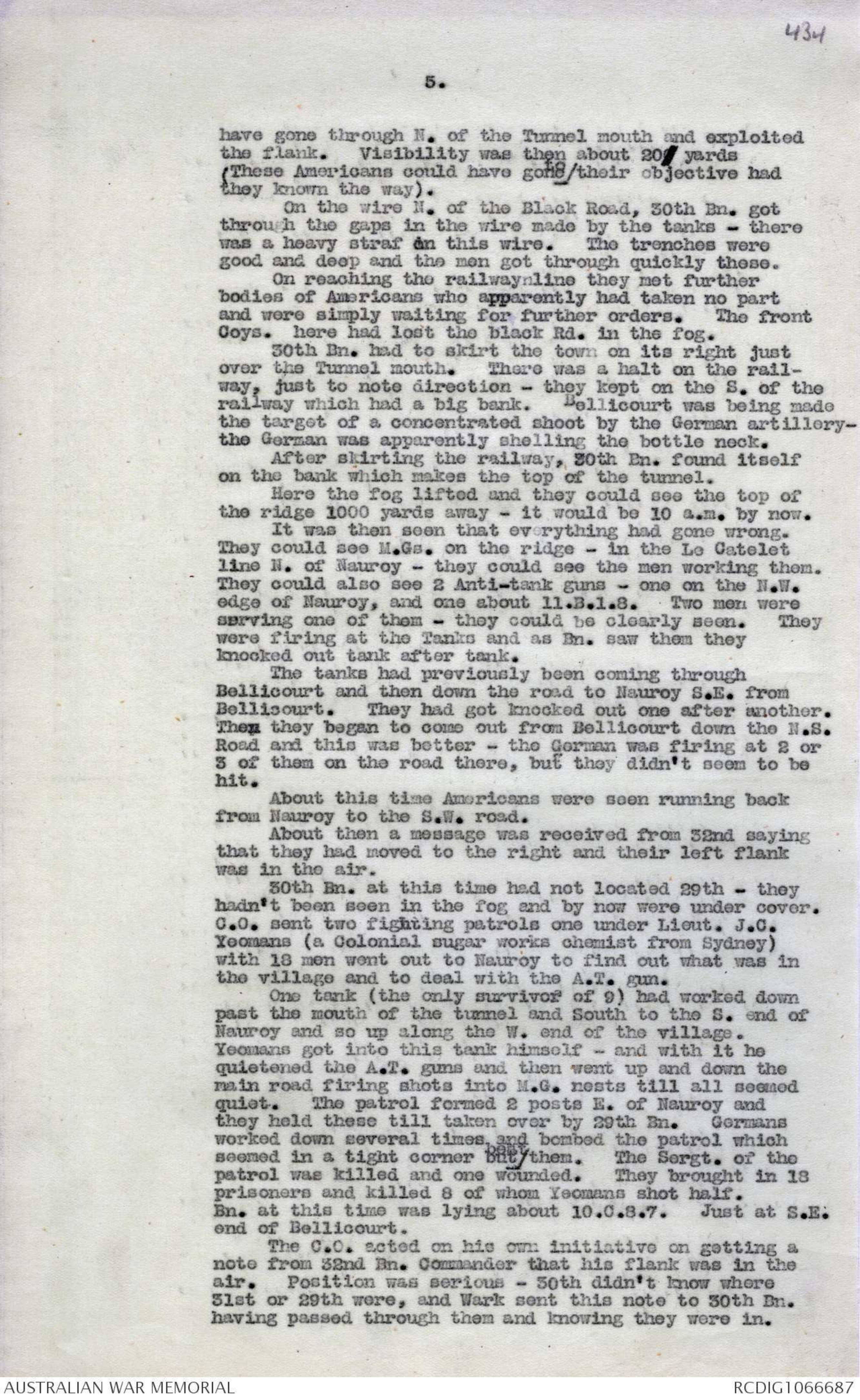
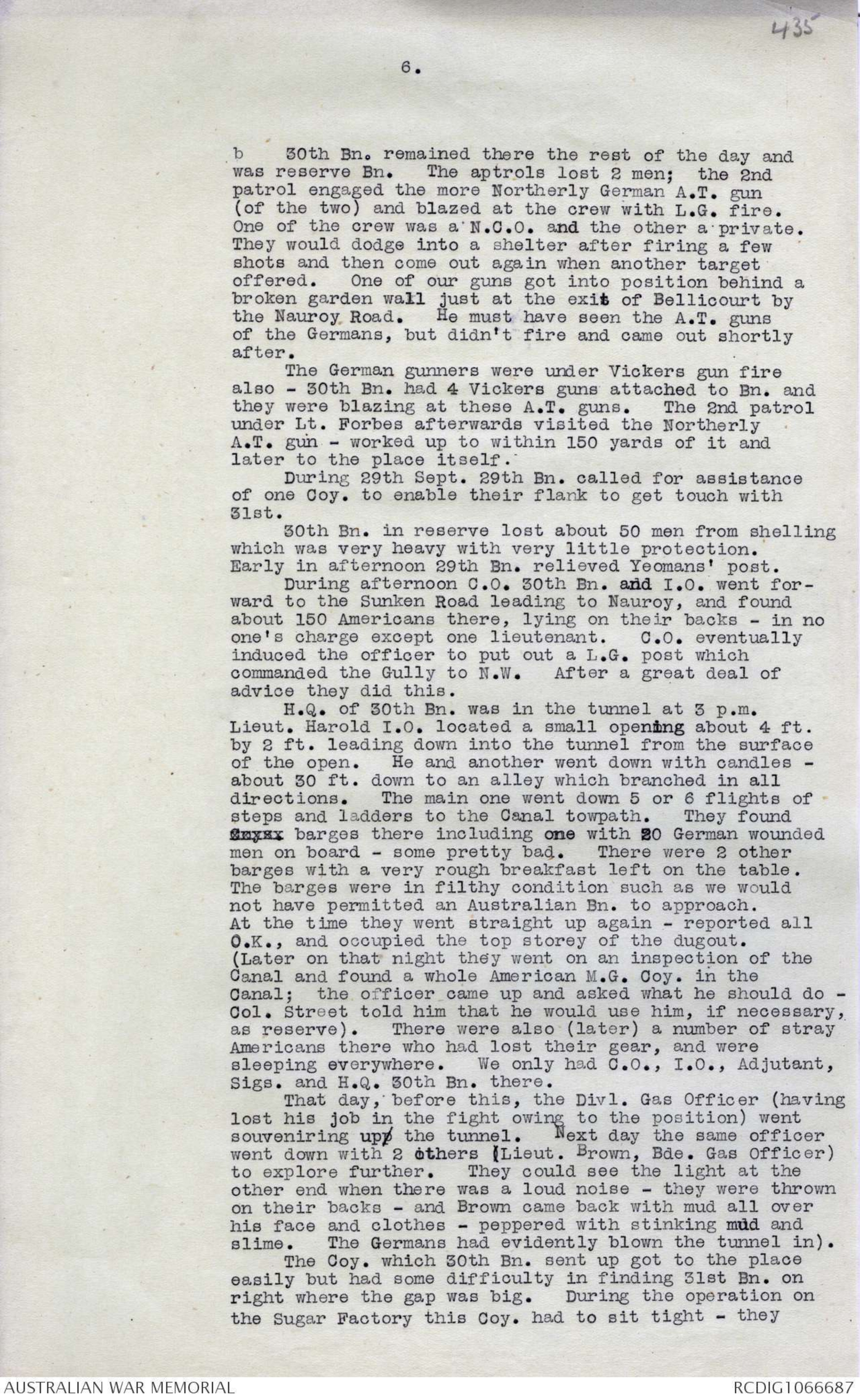
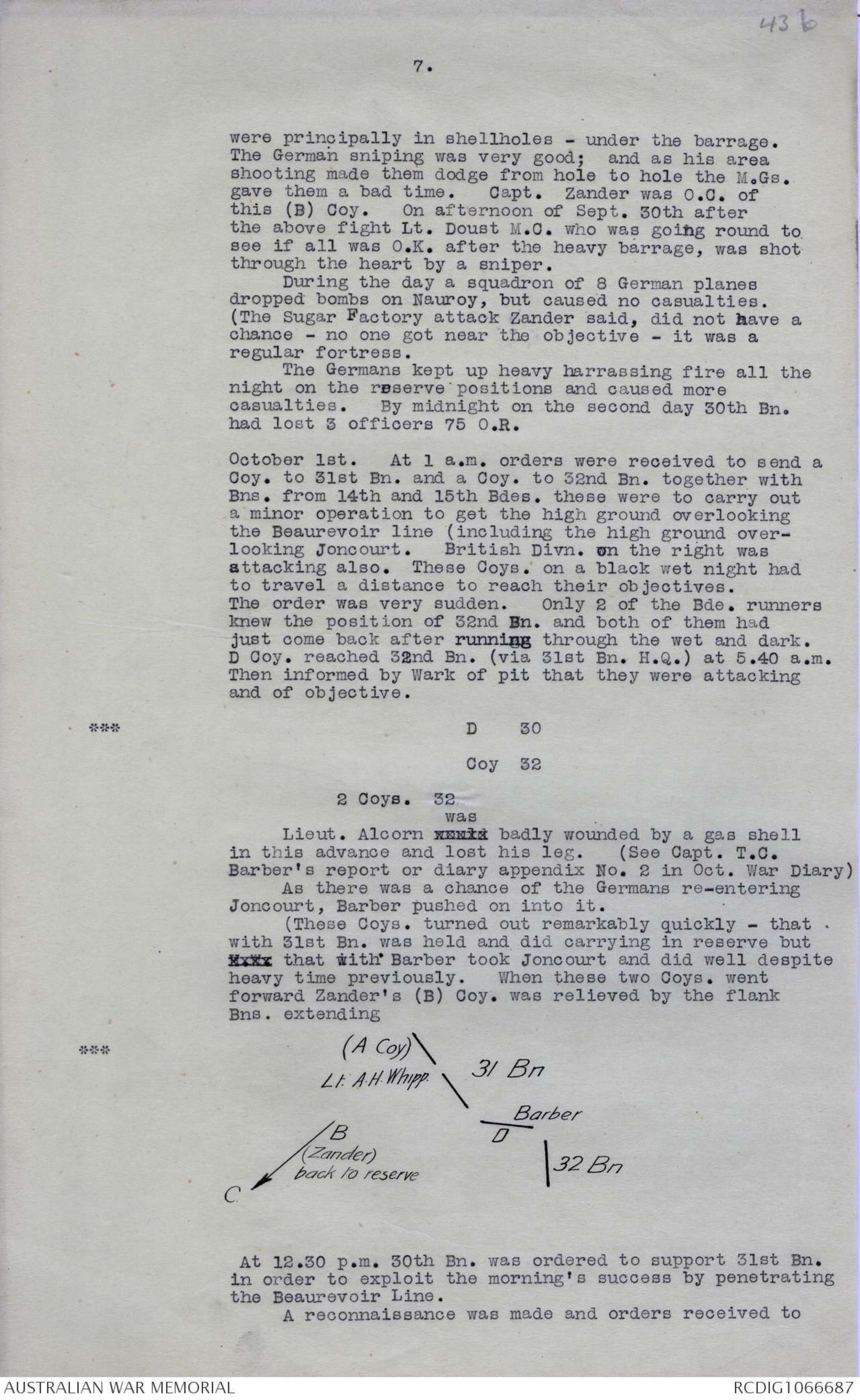
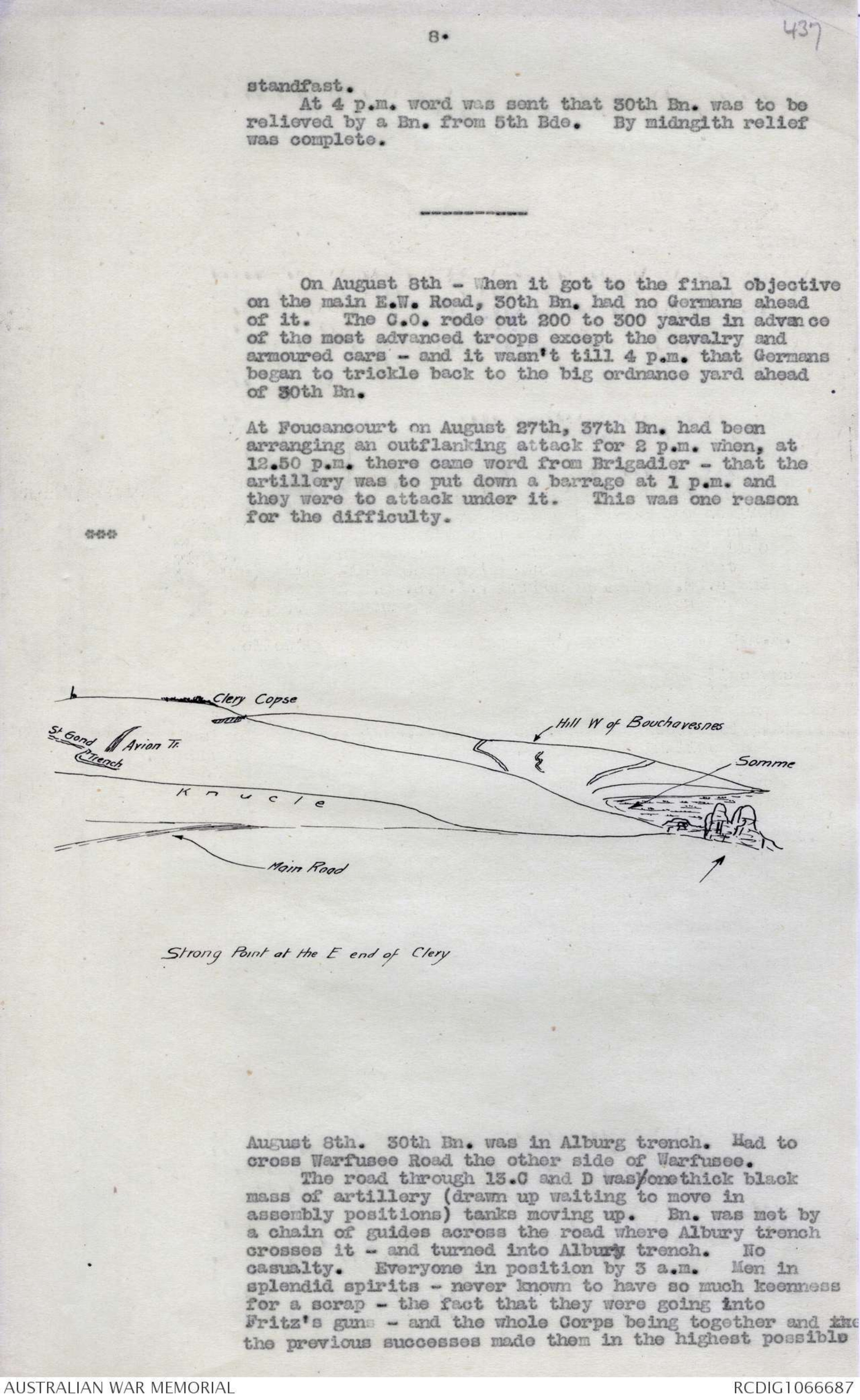
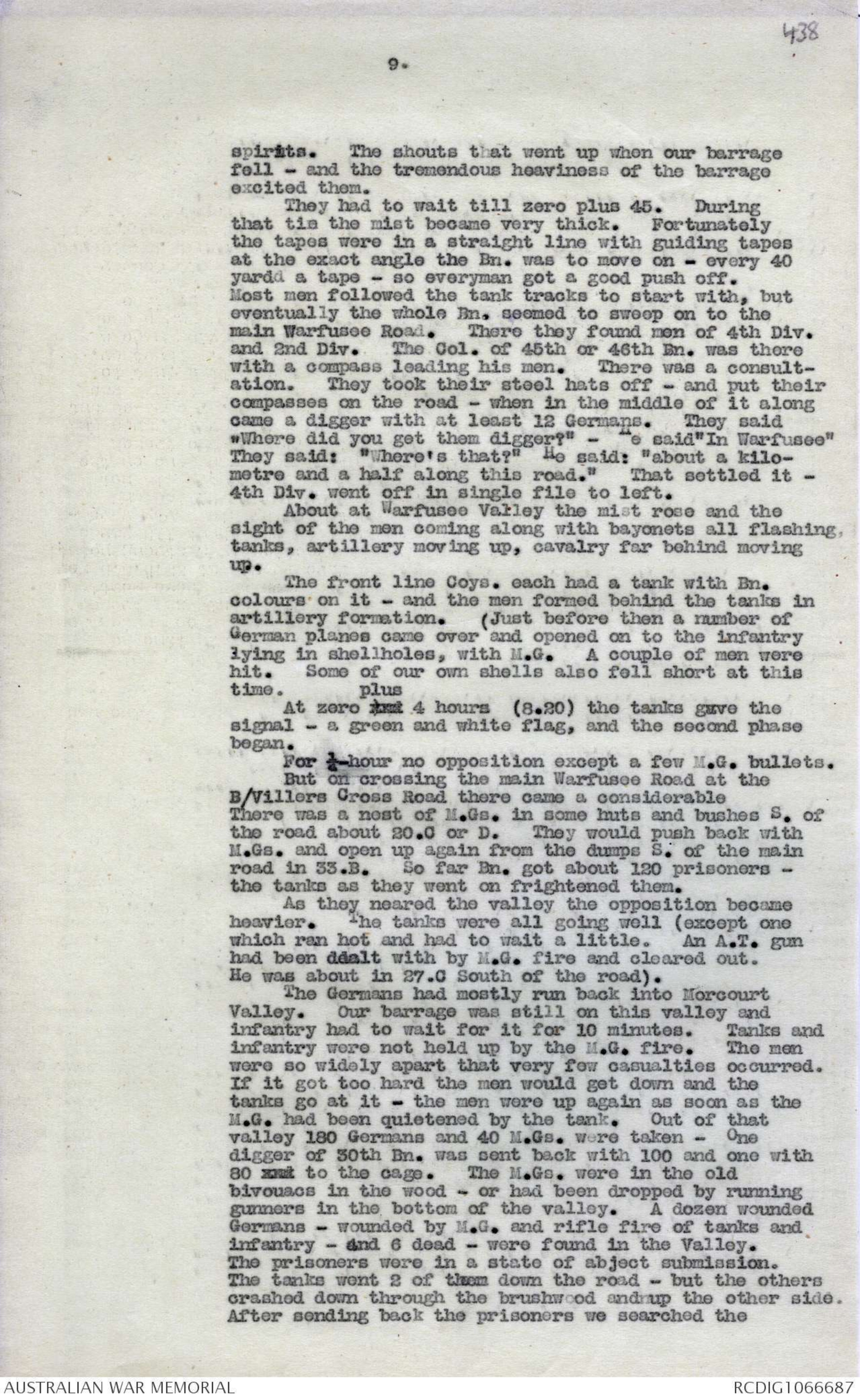
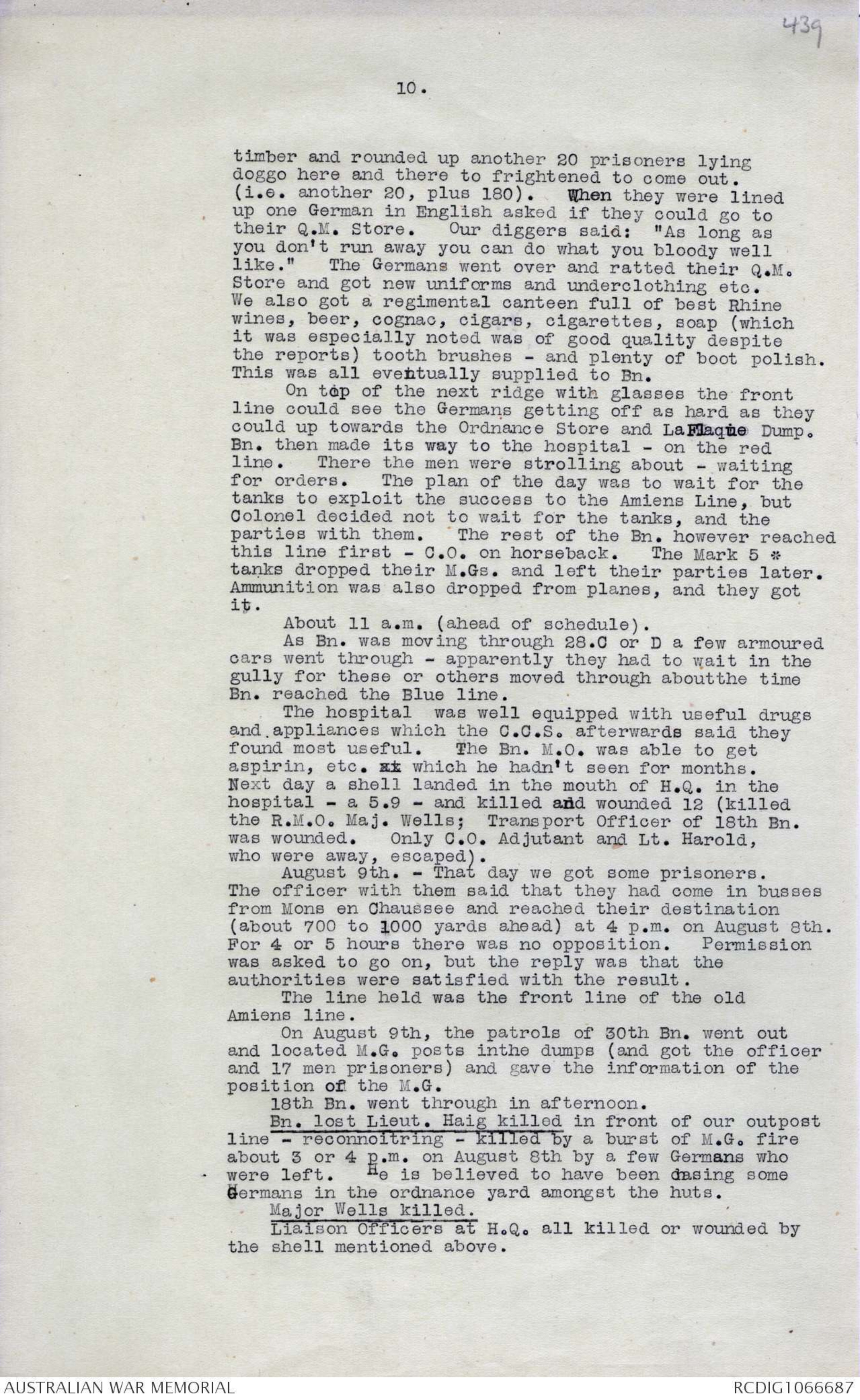
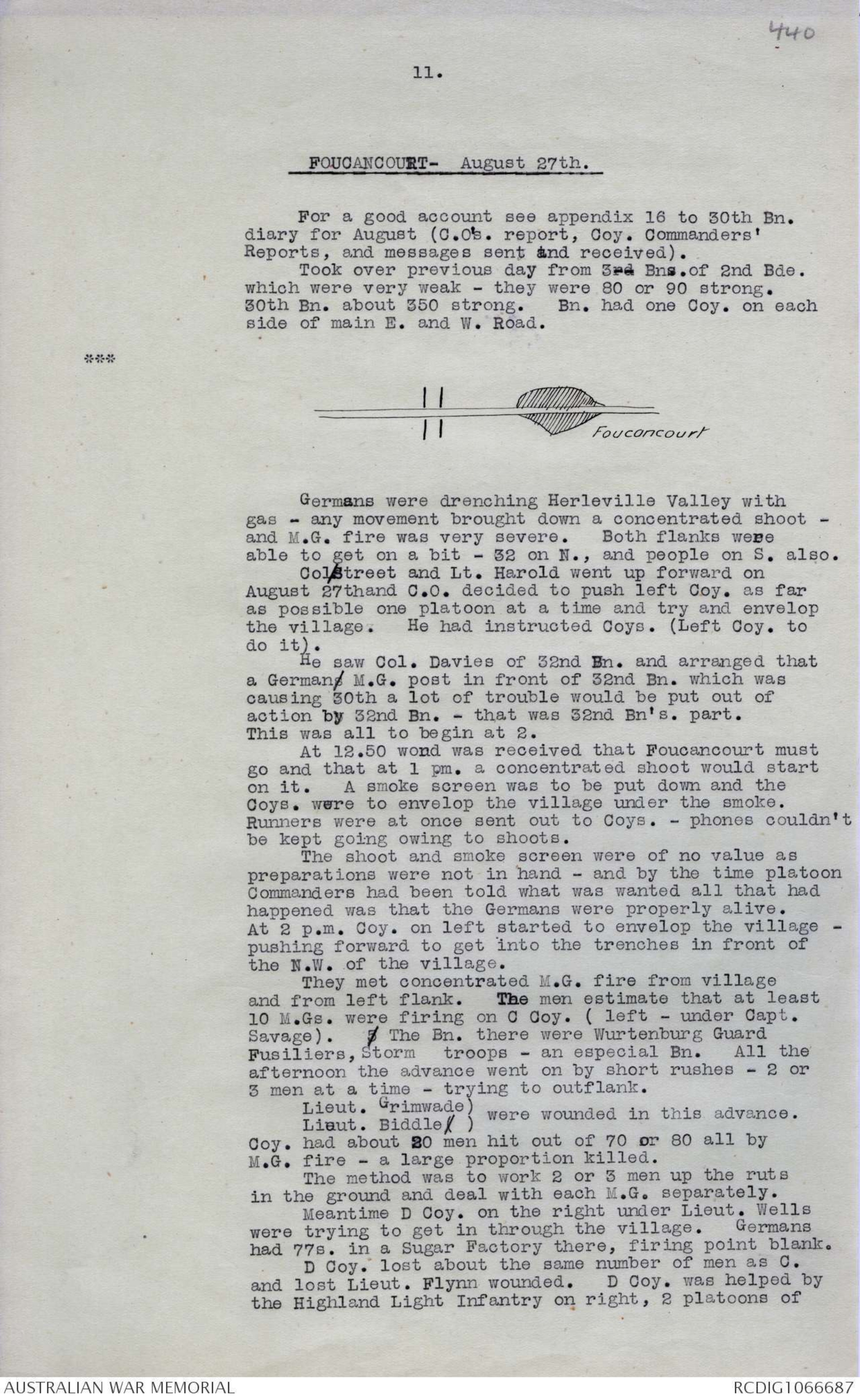
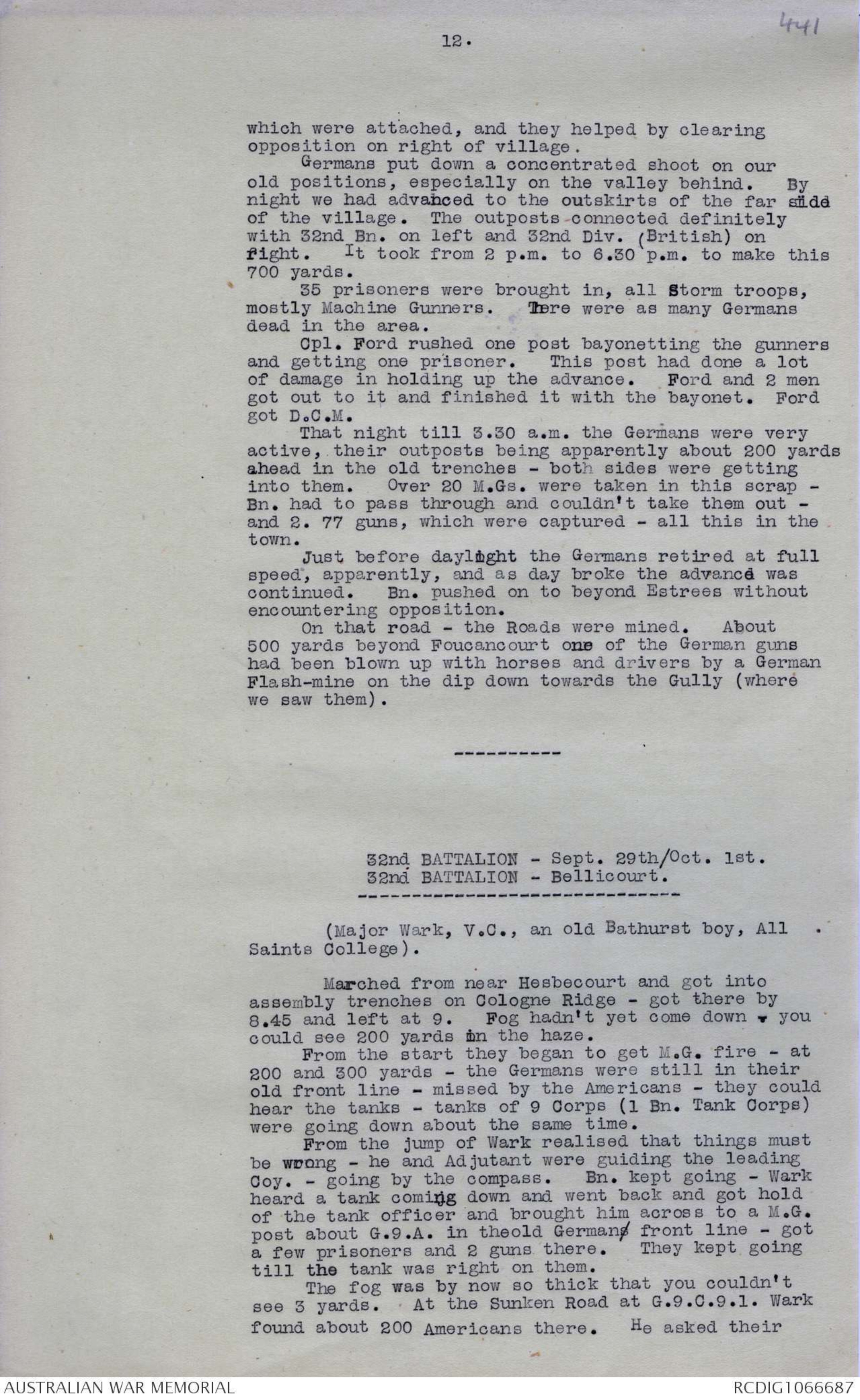
[*433*]
4.
It was taken on morning of Oct. 1st - when our
barrage came down HGermans xxx cleared. On. Oct.1st
in this advance Wark himself knocked out a German
M.G. on Mill Ridge leading his men right xxx on to it.
On first day Bde. didn't know what could be
happening on left - otherwise 30th Bn. would have
been put through 32nd Bn. where Geman Germans were
wrakest. G.O.C. would not take this risk as it was
the last reserve.
30th BATTALION.
29th September.
(From Lt. Harold, I.O.; and Adjutant).
Left Hervilly at 8 a.m. marching by Black Road.
Road was well marked and crowded with Batteries
and transport. Road was clear till 8 a.m. and 30th
Bn. just came up as transport started to move through
on to it. Bn. moved in artillery formation about
80 yards on either side of the road.
No shellfire till Villeret Ridge; but 100 yards
short of Villeret Ridge foxxnd found parties of American
and stragglers - 3 Americans in charge of 4 prisoners
etc.
They said that all was going well - so far as
30th Bn. knew everything had gone well.
The Ridge was absolutely crowded with batteries.
The smoke screen was put up actually amongst the guns -
by some sort of fog machine apparently - and it was
tremendous. It made a perfect screen for the guns.
It was perhaps up from the valley on the Villeret side
of the Ridge, and rolled over the Ridge in thick clouds
and formed a very dense mist in the valley the other
side. Volume after volume of the stuff seemed to be
coming over from behind the guns - the day was misty
and itlooked too much smoke. The guns had been in
the firstbarrage and were preparing to move to their
second position - and the smoke was no doubt to cover
their move from German aircraft.
As Bn. came down past the Farm they began to get
shellfire and scattered M.G. fire from the direction
of the Canal.
They thought a few M.Gs. must have been missed in
the fog. The German was firing blind but had his
gund well laid - it was not high. The old trenches
on either side of the road were well banked and the
parapets gave cover.
On reaching our front line we found it crowded
with Americans - none knowing what on earth was
happening but all ready to pack up and clear.
Their idea seemed to be that now that the
Australians were through them it was all finished and
they could go home. Neither officers nor men knew
anything.
Probably those Americans were those who should
[*434*]
5.
have gone through N. of the Tunnel mouth and exploited
the flank. Visibility was then about 209 yards
(These Americans could have gone ^to their objective had
they known the way).
On the wire N. of the Black Road, 30th Bn. got
through the gaps in the wire made by the tanks - there
was a heavy straf on this wire. The trenches were
good and deep and the men got through quickly these.
On reaching the railwaynline they met further
bodies of Americans who apparently had taken no part
and were simply waiting for further orders. The front
Coys. here had lost the black Rd. in the fog.
30th Bn. had to skirt the town on its right just
over the Tunnel mouth. There was a halt on the railway,
just to note direction - they kept on the S. of the
railway which had a big bank. Bellicourt was being made
the target of a concentrated shoot by the German artillery -
the German was apparently shelling the bottle neck.
After skirting the railway, 30th Bn. found itself
on the bank which makes the top of the tunnel.
Here the fog lifted and they could see the top of
the ridge 1000 yards away - it would be 10 a.m. by now.
It was then seen that everything had gone wrong.
They could see M.Gs. on the ridge - in the Le Catelet
line N. of Nauroy - they could see the men working them.
They could also see 2 Anti-tank guns - one on the N.W.
edge of Nauroy, and one about 11.B.1.8. Two men were
serving one of them - they could be clearly seen. They
were firing at the Tanks and as Bn. saw them they
knocked out tank after tank.
The tanks had previously been coming through
Bellicourt and then down the road to Nauroy S.E. from
Bellicourt. They had got knocked out one after another.
Then they began to come out from Bellicourt down the N.S.
Road and this was better - the German was firing at 2 or
3 of them on the road there, but they didn't seem to be
hit.
About this time Americans were seen running back
from Nauroy to the S.W. road.
About then a message was received from 32nd saying
that they had moved to the right and their left flank
was in the air.
30th Bn. at this time had not located 29th - they
hadn't been seen in the fog and by now were under cover.
C.O. sent two fighting patrols one under Lieut. J.C.
Yeomans (a Colonial sugar works chemist from Sydney)
with 18 men went out to Nauroy to find out what was in
the village and to deal with the A.T. gun.
One tank (the only survivor of 9) had worked down
past the mouth of the tunnel and South to the S. end of
Nauroy and so up along the W. end of the village.
Yeomans got into this tank himself - and with it he
quietened the A.T. guns and then went up and down the
main road firing shots into M.G. nests till all seemed
quiet. The patrol formed 2 posts E. of Nauroy and
they held these till taken over by 29th Bn. Germans
worked down several times, and bombed the patrol which
seemed in a tight corner but/beat them. The Sergt. of the
patrol was killed and one wounded. They brought in 18
prisoners and killed 8 of whom Yeomans shot half.
Bn. at this time was lying about 10.C.8.7. Just at S.E.
end of Bellicourt.
The C.O. acted on his own initiative on getting a
note from 32nd Bn. Commander that his flank was in the
air. Position was serious - 30th didn't know where
31st or 29th were, and Wark sent this note to 30th Bn.
having passed through them and knowing they were in.
[*434*]
5.
have gone through N. of the Tunnel mouth and exploited
the flank. Visibility was then about 209 yards
(These Americans could have gone ^to their objective had
they known the way).
On the wire N. of the Black Road, 30th Bn. got
through the gaps in the wire made by the tanks - there
was a heavy straf on this wire. The trenches were
good and deep and the men got through quickly these.
On reaching the railwaynline they met further
bodies of Americans who apparently had taken no part
and were simply waiting for further orders. The front
Coys. here had lost the black Rd. in the fog.
30th Bn. had to skirt the town on its right just
over the Tunnel mouth. There was a halt on the railway,
just to note direction - they kept on the S. of the
railway which had a big bank. Bellicourt was being made
the target of a concentrated shoot by the German artillery -
the German was apparently shelling the bottle neck.
After skirting the railway, 30th Bn. found itself
on the bank which makes the top of the tunnel.
Here the fog lifted and they could see the top of
the ridge 1000 yards away - it would be 10 a.m. by now.
It was then seen that everything had gone wrong.
They could see M.Gs. on the ridge - in the Le Catelet
line N. of Nauroy - they could see the men working them.
They could also see 2 Anti-tank guns - one on the N.W.
edge of Nauroy, and one about 11.B.1.8. Two men were
serving one of them - they could be clearly seen. They
were firing at the Tanks and as Bn. saw them they
knocked out tank after tank.
The tanks had previously been coming through
Bellicourt and then down the road to Nauroy S.E. from
Bellicourt. They had got knocked out one after another.
Then they began to come out from Bellicourt down the N.S.
Road and this was better - the German was firing at 2 or
3 of them on the road there, but they didn't seem to be
hit.
About this time Americans were seen running back
from Nauroy to the S.W. road.
About then a message was received from 32nd saying
that they had moved to the right and their left flank
was in the air.
30th Bn. at this time had not located 29th - they
hadn't been seen in the fog and by now were under cover.
C.O. sent two fighting patrols one under Lieut. J.C.
Yeomans (a Colonial sugar works chemist from Sydney)
with 18 men went out to Nauroy to find out what was in
the village and to deal with the A.T. gun.
One tank (the only survivor of 9) had worked down
past the mouth of the tunnel and South to the S. end of
Nauroy and so up along the W. end of the village.
Yeomans got into this tank himself - and with it he
quietened the A.T. guns and then went up and down the
main road firing shots into M.G. nests till all seemed
quiet. The patrol formed 2 posts E. of Nauroy and
they held these till taken over by 29th Bn. Germans
worked down several times, and bombed the patrol which
seemed in a tight corner but ^beat them. The Sergt. of the
patrol was killed and one wounded. They brought in 18
prisoners and killed 8 of whom Yeomans shot half.
Bn. at this time was lying about 10.C.8.7. Just at S.E.
end of Bellicourt.
The C.O. acted on his own initiative on getting a
note from 32nd Bn. Commander that his flank was in the
air. Position was serious - 30th didn't know where
31st or 29th were, and Wark sent this note to 30th Bn.
having passed through them and knowing they were in.
[*435*]
6.
b 30th Bn. remained there the rest of the day and
was reserve Bn. The aptrols lost 2 men; the 2nd
patrol engaged the more Northerly German A.T. gun
(of the two) and blazed at the crew with L.G. fire.
One of the crew was a N.C.O. and the other a private.
They would dodge into a shelter after firing a few
shots and then come out again when another target
offered. One of our guns got into position behind a
broken garden wall just at the exist of Bellicourt by
the Nauroy Road. He must have seen the A.T. guns
of the Germans, but didn't fire and came out shortly
after.
The German gunners were under Vickers gun fire
also - 30th Bn. had 4 Vickers guns attached to Bn. and
they were blazing at these A.T. guns. The 2nd patrol
under Lt. Forbes afterwards visited the Northerly
A.T. gun. - worked up to within 150 yards of it and
later to the place itself.
During 29th Sept. 29th Bn. called for assistance
of one Coy. to enable their flank to get touch with
31st.
30th Bn. in reserve lost about 50 men from shelling
which was very heavy with very little protection.
Early in afternoon 29th Bn. relieved Yeomans’ post.
During afternoon C.O. 30th Bn. adnd I.O. went forward
to the Sunken Road leading to Nauroy, and found
about 150 Americans there, lying on their backs - in no
one's charge except one lieutenant. C.O. eventually
induced the officer to put out a L.G. post which
commanded the Gully to N.W. After a great deal of
advice they did this.
H.Q. of 30th Bn. was in the tunnel at 3 p.m.
Lieut. Harold I.O. located a small opening about 4 ft.
by 2 ft. leading down into the tunnel from the surface
of the open. He and another went down with candles -
about 30 ft. down to an alley which branched in all
directions. The main one went down 5 or 6 flights of
steps and ladders to the Canal towpath. They foundCoys.barges there including one with 320 German wounded
men on board - some pretty bad. There were 2 other
barges with a very rough breakfast left on the table.
The barges were in filthy condition such as we would
not have permitted an Australian Bn. to approach.
At the time they went straight up again - reported all
O.K., and occupied the top storey of the dugout.
(Later on that night they went on an inspection of the
Canal and found a whole American M.G. Coy. in the
Canal; the officer came up and asked what he should do
Col. Street told him that he would use him, if necessary
as reserve). There were also (later) a number of stray
Americans there who had lost their gear, and were
sleeping everywhere. We only had C.O., I.O., Adjutant,
Sigs. and H.Q. 30th Bn. there.
That day, before this, the Divl. Gas Officer (having
lost his job in the fight owing to the position) went
souveniring upp the tunnel. Next day the same officer
went down with 2 others (Lieut. Brown, Bde. Gas Officer)
to explore further. They could see the light at the
other end when there was a loud noise - they were thrown
on their backs - and Brown came back with mud all over
his face and clothes - peppered with stinking mdud and
slime. The Germans had evidently blown the tunnel in).
The Coy. which 30th Bn. sent up got to the place
easily but had some difficulty in finding 31st Bn. on
right where the gap was big. During the operation on
the Sugar Factory this Coy. had to sit tight - they
[*436*]
7.
were principally in shellholes - under the barrage.
The German sniping was very good; and as his area
shooting made them dodge from hole to hole the M.Gs.
gave them a bad time. Capt. Zander was O.C. of
this (B) Coy. On afternoon of Sept. 30th after
the above fight Lt. Doust M.C. who was goiing round to
see if all was O.K. after the heavy barrage, was shot
through the heart by a sniper.
During the day a squadron of 8 German planes
dropped bombs on Nauroy, but caused no casualties.
(The Sugar Factory attack Zander said, did not have a
chance - no one got near the objective - it was a
regular fortress.
The Germans kept up heavy harrassing fire all the
night on the reserve positions and caused more
casualties. By midnight on the second day 30th Bn.
had lost 3 officers 75 O.R.
October 1st. At 1 a.m. orders were received to send a
Coy. to 31st Bn. and a Coy. to 32nd Bn. together with
Bns. from 14th and 15th Bdes. these were to carry out
a minor operation to get the high ground overlooking
the Beaurevoir line (including the high ground overlooking
Joncourt. British Divn. on the right was
attacking also. These Coys. on a black wet night had
to travel a distance to reach their objectives.
The order was very sudden. Only 2 of the Bde. runners
knew the position of 32nd Bn. and both of them had
just come back after running through the wet and dark.
D Coy. reached 32nd Bn. (via 31st Bn. H.Q.) at 5.40 a.m.
Then informed by Wark of pit that they were attacking
and of objective.
*** D 30
Coy 32
2 Coys. 32
Lieut. Alcorn would was badly wounded by a gas shell
in this advance and lost his leg. (See Capt. T.C.
Barber's report or diary appendix No. 2 in Oct. War Diary)
As there was a chance of the Germans re-entering
Joncourt, Barber pushed on into it.
(These Coys. turned out remarkably quickly - that.
with 31st Bn. was held and did carrying in reserve butHxWx that with Barber took Joncourt and did well despite
heavy time previously. When these two Coys. went
forward Zander’'s (B) Coy. was relieved by the flank
Bns. extending
*** Diagram - see original document
At 12.30 p.m. 30th Bn. was ordered to support 31st Bn.
in order to exploit the morning's success by penetrating
the Beaurevoir Line.
A reconnaissance was made and orders received to
[*437*]
8.
standfast.
At 4 p.m. word was sent that 30th Bn. was to be
relieved by a Bn. from 5th Bde. By midngith relief
was complete.
On August 8th - When it got to the final objective
on the main E.W. Road, 30th Bn. had no Germans ahead
of it. The C.O. rode out 200 to 300 yards in advance
of the most advanced troops except the cavalry and
armoured cars - and it wasn't till 4 p.m. that Germans
began to trickle back to the big ordnance yard ahead
of 30th Bn.
At Foucancourt on August 27th, 37th Bn. had been
arranging an outflanking attack for 2 p.m. when, at
12.50 p.m. there came word from Brigadier - that the
artillery was to put down a barrage at 1 p.m. and
they were to attack under it. This was one reason
for the difficulty.
***
Diagram - see original document
August 8th. 30th Bn. was in Alburg trench. Had to
Cross Warfusee Road the other side of Warfusee.
The road through 13.C and D was bonethick black
mass of artillery (drawn up waiting to move in
assembly positions) tanks moving up. Bn. was met by
a chain of guides across the road where Albury trench
crosses it - and turned into Albury trench. No
casualty. Everyone in position by 3 a.m. Men in
splendid spirits - never known to have so much keenness
for a scrap - the fact that they wore going into
Fritz's guns - and the whole Corps being together and the
the previous successes made them in the highest possible
[*438*]
9.
spirits. The shouts that went up when our barrage
fell - and the tremendous heaviness of the barrage
excited them.
They had to wait till zero plus 45. During
that tie the mist became very thick. Fortunately
the tapes were in a straight line with guiding tapes
at the exact angle the Bn. was to move on - every 40
yardd a tape - so everyman got a good push off.
Most men followed the tank tracks to start with, but
eventually the whole Bn. seemed to sweep on to the
main Warfusee Road. There they found men of 4th Div.
and 2nd Div. The Col. of 45th or 46th Bn. was there
with a compass leading his men. There was a consultation.
They took their steel hats off - and put their
compasses on the road - when in the middle of it along
came a digger with at least 12 Germans. They said
"Where did you get them digger?" - He said "In Warfusee"
They said: "Where's that?". He said: "about a kilometre
and a half along this road." That settled it -
4th Div. went off in single file to left.
About at Warfusee Valley the mist rose and the
sight of the men coming along with bayonets all flashing
tanks, artillery moving up, cavalry far behind moving
up.
The front line Coys. each had a tank with Bn.
colours on it - and the men formed behind the tanks in
artillery formation. (Just before then a number of
German planes came over and opened on to the infantry
lying in shellholes, with M.G. A couple of men were
hit. Some of our own shells also fell short at this
time.
At zero xxx plus 4 hours (8.20) the tanks gave the
signal - a green and white flag, and the second phase
began.
For ¼-hour no opposition except a few M.G. bullets.
But on crossing the main Warfusee Road at the
B/Villers Cross Road there came a considerable
There was a nest of M.Gs. in some huts and bushes S. of
the road about 20.C or D. They would push back with
M.Gs. and open up again from the dumps S. of the main
road in 33.B. So far Bn. got about 120 prisoners -
the tanks as they went on frightened them.
As they neared the valley the opposition became
heavier. The tanks were all going well (except one
which ran hot and had to wait a little. An A.T. gun
had been dealt with by M.G. fire and cleared out.
He was about in 27.C South of the road).
The Germans had mostly run back into Morcourt
Valley. Our barrage was still on this valley and
infantry had to wait for it for 10 minutes. Tanks and
infantry wore not held up by the M.G. fire. The men
were so widely apart that very few casualties occurred.
If it got too hard the men would get down and the
tanks go at it - the men were up again as soon as the
M.G. had been quietened by the tank. Out of that
valley 180 Germans and 40 M.Gs. were taken - One
digger of 30th Bn. was sent back with 100 and one with
80 and to the cage. The M.Gs. were in the old
bivouacs in the wood - or had been dropped by running
gunners in the bottom of the valley. A dozen wounded
Germans - wounded by M.G. and rifle fire of tanks and
infantry - 1and 6 dead - wore found in the Valley.
The prisoners wore in a state of abject submission.
The tanks went 2 of them down the road — but the others
crashed down through the brushwood and up the other side.
After sending back the prisoners we searched the
[*439*]
10.
timber and rounded up another 20 prisoners lying
doggo here and there to frightened to come out.
(i.e. another 20, plus 180). When they were lined
up one German in English asked if they could go to
their Q.M. Store. Our diggers said: "As long as
you don't run away you can do what you bloody well
like." The Germans went over and ratted their Q.M.
Store and got new uniforms and underclothing etc.
We also got a regimental canteen full of best Rhine
wines, beer, cognac, cigars, cigarettes, soap (which
it was especially noted was of good quality despite
the reports) tooth brushes - and plenty of boot polish.
This was all eventually supplied to Bn.
On tiop of the next ridge with glasses the front
line could see the Germans getting off as hard as they
could up towards the Ordnance Store and LaFlaqiue Dump.
Bn. then made its way to the hospital - on the red
line. There the men were strolling about - waiting
for orders. The plan of the day was to wait for the
tanks to exploit the success to the Amiens Line, but
Colonel decided not to wait for the tanks, and the
parties with them. The rest of the Bn. however reached
this line first - C.O. on horseback. The Mark 5 *
tanks dropped their M.G.s. and left their parties later.
Ammunition was also dropped from planes, and they got
it.
About 11 a.m. (ahead of schedule).
As Bn. was moving through 28.C or D a few armoured
cars went through - apparently they had to wait in the
gully for these or others moved through aboutthe time
Bn. reached the Blue line.
The hospital was well equipped with useful drugs
and appliances which the C.C.S. afterwards said they
found most useful. The Bn. M.O. was able to get
aspirin, etc. at which he hadn't seen for months.
Next day a shell landed in the mouth of H.Q. in the
hospital - a 5.9 - and killed and wounded 12 (killed
the R.M.O. Maj. Wells; Transport Officer of 18th Bn.
was wounded. Only C.O. Adjutant and Lt. Harold,
who were away, escaped).
August 9th. - That day we got some prisoners.
The officer with them said that they had come in busses
from Mons en Chaussee and reached their destination
(about 700 to 1000 yards ahead) at 4 p.m. on August 8th.
For 4 or 5 hours there was no opposition. Permission
was asked to go on, but the reply was that the
authorities were satisfied with the result.
The line hold was the front line of the old
Amiens line.
On August 9th, the patrols of 30th Bn. went out
and located M.G. posts inthe dumps (and got the officer
and 17 men prisoners) and gave the information of the
position of the M.G.
18th Bn. went through in afternoon.
Bn. lost Lieut. Haig killed in front of our outpost
line - reconnoitring - killed by a burst of M.G. fire
about 3 or 4 p.m. on August 8th by a few Germans who
were left. He is believed to have been dchasing some
Germans in the ordnance yard amongst the huts.
Major Wells Killed.
Liaison Officers at H.Q. all killed or wounded by
the shell mentioned above.
[*440*]
11.
FOUCANCOURT— August 27th.
For a good account see appendix 16 to 30th Bn.
diary for August (C.O's. report, Coy. Commanders'
Reports, and messages sent and received).
Took over previous day from 3rd Bns. of 2nd Bde.
which were very weak - they were 80 or 90 strong.
30th Bn. about 350 strong. Bn. had one Coy. on each
side of main E. and W. Road.
***
Diagram - see original document
Germans were drenching Herleville Valley with
gas - any movement brought down a concentrated shoot -
and M.G. fire was very severe. Both flanks were
able to get on a bit - 32 on N., and people on S. also.
Col/Street and Lt. Harold went up forward on
August 27thand C.O. decided to push left Coy. as far
as possible one platoon at a time and try and envelop
the village. He had instructed Coys. (Left Coy. to
do it).
He saw Col. Davies of 32nd Bn. and arranged that
a Germans M.G. post in front of 32nd Bn. which was
causing 30th a lot of trouble would be put out of
action by 32nd Bn. - that was 32nd Bns. part.
This was all to begin at 2.
At 12.50 word was received that Foucancourt must
go and that at 1 pm. a concentrated shoot would start
on it. A smoke screen was to be put down and the
Coys. were to envelop the village under the smoke.
Runners were at once sent out to Coys. - phones couldn’t
be kept going owing to shoots.
The shoot and smoke screen were of no value as
preparations were not in hand - and by the time platoon
Commanders had been told what was wanted all that had
happened was that the Germans were properly alive.
At 2 p.m. Coy. on left started to envelop the village
pushing forward to get into the trenches in front of
the N.W. of the village.
They met concentrated M.G. fire from village
and from left flank. The men estimate that at least
10 M.Gs. were firing on C Coy. (left - under Capt.
Savage). 5 The Bn. there were Wurtenburg Guard
Fusiliers, Storm troops - an especial Bn. All the
afternoon the advance went on by short rushes - 2 or
3 men at a time - trying to outflank.
Lieut. Grimwade)
Lieut. Biddle ( ) were wounded in this advance.
Coy. had about 20 men hit out of 70 or 80 all by
M.G. fire - a large proportion killed.
The method was to work 2 or 3 men up the ruts
in the ground and deal with each M.G. separately.
Meantime D Coy. on the right under Lieut. Wells
were trying to get in through the village. Germans
had 77s. in a Sugar Factory there, firing point blank.
D Coy. lost about the same number of men as C.
and lost Lieut. Flynn wounded. D Coy. was helped by
the Highland Light Infantry on right, 2 platoons of
[*441*]
12.
which were attached, and they helped by clearing
opposition on right of village.
Germans put down a concentrated shoot on our
old positions, especially on the valley behind. By
night we had advanced to the outskirts of the far slide
of the village. The outposts connected definitely
with 32nd Bn. on left and 32nd Div. (British) on
right. It took from 2 p.m. to 6.30 p.m. to make this
700 Yards.
35 prisoners were brought in, all Storm troops,
mostly Machine Gunners. There were as many Germans
dead in the area.
Cpl. Ford rushed one post bayonetting the gunners
and getting one prisoner. This post had done a lot
of damage in holding up the advance. Ford and 2 men
got out to it and finished it with the bayonet. Ford
got D.C.M.
That night till 3.30 a.m. the Germans were very
active, their outposts being apparently about 200 yards
ahead in the old trenches - both sides were getting
into them. Over 20 M.Gs. were taken in this scrap -
Bn. had to pass through and couldn't take them out -
and 2. 77 guns, which were captured - all this in the
town.
Just before daylight the Germans retired at full
speed, apparently, and as day broke the advance was
continued. Bn. pushed on to beyond Estrees without
encountering opposition.
On that road - the Roads were mined. About
500 yards beyond Foucancourt one of the German guns
had been blown up with horses and drivers by a German
Flash-mine on the dip down towards the Gully (where
we saw them).
32nd BATTALION - Sept. 29th/Oct. 1st.
32nd BATTALION - Bellicourt.
(Major Wark, V.C., an old Bathurst boy, All
Saints College).
Marched from near Hesbecourt and got into
assembly trenches on Cologne Ridge - got there by
8.45 and left at 9. Fog hadn't yet come down, you
could see 200 Yards in the haze.
From the start they began to get M.G. fire - at
200 and 300 yards - the Germans were still in their
old front line - missed by the Americans - they could
hear the tanks - tanks of 9 Corps (1 Bn. Tank Corps)
were going down about the same time.
From the jump of Wark realised that things must
be wrong - he and Adjutant were guiding the leading
Coy. - going by the compass. Bn. Kept going - Wark
heard a tank coming down and went back and got hold
of the tank officer and brought him across to a M.G.
post about G.9.A. in theold Germans front line - got
a few prisoners and 2 guns there. They kept going
till the tank was right on them.
The fog was by now so thick that you couldn’t
see 3 Yards. At the Sunken Road at G.9.C.9.1. Wark
found about 200 Americans there. He asked their
 Diane Ware
Diane WareThis transcription item is now locked to you for editing. To release the lock either Save your changes or Cancel.
This lock will be automatically released after 60 minutes of inactivity.